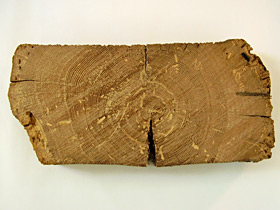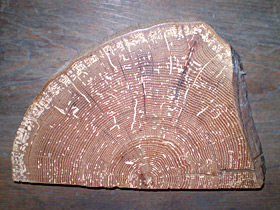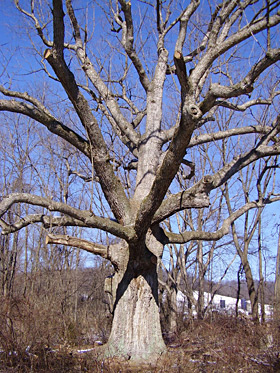Scientists and scholars
of various disciplines have been using recent advances
in dendrochronology, or tree-ring dating studies, in
the Northeast along with the development of regional
master chronologies for various species of trees to
promote the dating of timber framed buildings and other
buildings that have timbers somewhere in their construction.
Although the science of dendrochronology was first formulated
about 1905, it has only until very recently, perhaps
since 2000, that the science has gained much popularity
with private homeowners. Before that time, the science,
art and philosophy of dendrochronology – aka –
dendro-dating – was mostly limited to the determination
of ages of buildings under the control of certain public
and some private institutions. However, the home owner
is becoming more and more interested in knowing the
exact dates of construction of both their houses and
their barns.

The oak slice from
the Taylor stone Lancashire style ground barn located
just west of West Chester in Chester County, Pennsylvania
was dendro-dated to 1752. This date established
the structure to be the earliest basically intact
and scientifically verified barn in all of Pennsylvania.
|
|

The oak slice from
the Tredyffrin double log crib English Lake District
style bank barn located near Devon in Chester County,
Pennsylvania was dendro-dated to 1779. This barn
type is an extreme rarity in Pennsylvania. |
Dendro-dating can be a very
effective although not foolproof way of creating data
that can often lead to discerning the age of construction
of various buildings and structures in the northeast
and beyond. There are, however, certain criteria that
must be satisfied or met in order that a wood testing
on any particular building will yield good to even excellent
but not guaranteed results.

This small 3 by 5 inch
hemlock brace from a barn in western Massachusetts
has a remarkable 270 annual growth rings making
the average width of each ring extremely narrow.
(Photo courtesy of Shaun Garvey.) |
|

The field grown Sacred
Oak in the Oley Valley in Berks County, Pennsylvania
has been connected to Native Americans for hundreds
of years. Fully intact slices of tree trunk would
yield hundreds of annual growth rings. The tree
is called a chinquapin or yellow oak. The tree is
now thriving under the wonderful care of a new owner.
|
Not all wood samples from timber frames or other beams
in various buildings and structures are good candidates
for dendrodating. There are four basic criteria that
must generally be met. They are the following:
The first criterion is that a waney edge must be present
in the obtained wood sample – either a core of
wood or slice of wood. Wane is the area of wood that
was immediately adjacent to the bark in a tree. Wane
is significant as this was the last annual growth ring
to be deposited, so to speak, before the tree was felled.
If, by using the method of dendro-dating, it can be
determined when the outermost ring was formed the possibility
exists that the construction date of a timbered building
might be determined.
The second criterion is that the wood sample can not
be so infested with powder post beetle that the proper
“bulk” of wood is not present. In addition,
the wood can not be so deteriorated by other destructive
agents that the wood bulk is affected. Ultimately, what
must be present in the wood sample is a “clear
path” of good wood (often straight path) from
the waney edge to the center of the tree or pith. This
path can theoretically be as little as about one-half
inch in width. Beyond the pith the condition of the
wood is immaterial. In fact, the wood sample can be
cut off just beyond the pith and not affect the dendro-dating
work.
The third criterion is that the wood sample must cross
date well. An explanation of this phenomenon is very
involved. Suffice it to say it is related to a number
of environmental factors. Not all wood samples with
good waney edges and that are not infested turn out
to cross date well.
The last criterion is seen where dendro-dating is used
so that a timber framed building may be dated, that
is, when the construction occurred – where there
is the assumption that the timber or tree the wood sample
came from was felled the year (or perhaps one to two
years) before the structure was erected. The other requirement
was that it was used in the original construction of
the building, that is, not recycled.
If all of these basic criteria are faithfully met, then
it may be said that the building was very likely constructed
the year (or possibly the second year) after the timber
or tree was felled. Again, there is no guarantee that
the science of dendro-dating will absolutely yield or
reflect a time of original construction of any timbered
building.

Eastern Barn Consultants will determine
what costs are involved in the dating of a particular
building and this information will be given to a prospective
client. It is imperative to know that the stated costs
will be in full effect assuming that good and proper
wood samples may be obtained. In the process of extracting
wood samples in the past there would have been occasions
when a good sample could not be obtained. This may be
for a number of reasons. Good cores, and not too often
wood slices or sections may be extracted in their “full
form.” Occasionally a few attempts are made to
extract cores or slices from the same beam. If this
is the case, other attempts are made to extract cores
or slices from other beams in the same building. Some
buildings do not yield good cores even if a prior determination
has been made that a certain beam or beams in a specific
building is (are) likely good candidate(s). In this
eventuality, Eastern Barn Consultants
must still charge for the effort to obtain a good sample.
If more than one building is to be dendro-dated on the
same day, that is, cores or slices to be obtained, then
there will be charges for the first building. If attempts
fail for the second building then there will be a separate
charge. This charge applies to certain geographic areas.
Areas beyond about 50 miles from the home base will
dictate different charges depending on the area.
Proviso
Eastern Barn Consultants specifically does dendro-dating
work for purposes of general information only –
that is – for the general interest and curiosity
of its clients. The company can not assume responsibility
for any subsequent damages of any kind that may result
from the determinations of establishing a supposed felling
date for a timber or timbers that were incorporated
into a building. The felling date or dates, determined
by a lab deemed reputable by Eastern Barn Consultants
are then used for a likely date of construction of a
building within about 1 to 3 years after the date of
felling. However, and most importantly, there is no
absolute guarantee that the “apparent” date
of construction determined by dendro-dating was the
actual construction date of the building or structure
in question. A client may or may not at his own discretion
base a historic restoration or renovation of a building
on the determined dendro-date of a building. Therefore,
the client is expressly told by Eastern Barn Consultants
that they should consult a professional architect versed
in historical buildings and their construction techniques
what era of construction should be the basis of a restoration
or renovation. Eastern Barn Consultants can not be held
liable for any subsequent damages of any kind at any
time that involves any work by anyone hired directly
or indirectly by the client of Eastern Barn Consultants
who may rely on the “established dendro-date”.
Gregory D. Huber
|
|